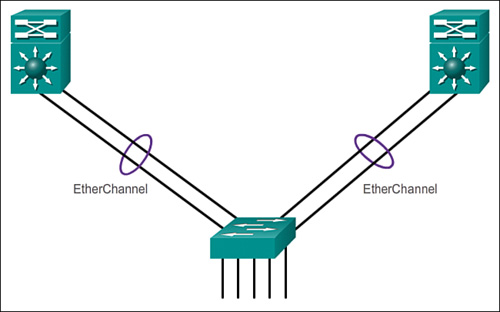
Table of Contents Link to heading
Link Aggregation Link to heading
the process of grouping multiple physical interfaces (ports) into one logical channel.
- One technology used primarily on Cisco switches is EtherChannel.
- A Port Channel interface is the logical representation of the EtherChannel on the switch.
- Multiple Fast or Gigabit Ethernet links can be bundled into a single L2 or L3
logical link.
- However, L2 and L3 interfaces cannot be bundled into the same port channel.
- Port bundling can occur such that multiple interfaces share one logical address (i.e. IP) or one physical address (i.e. MAC address).
- Open-standard Link Aggregation Control Protocol (LACP) allows for up to 8
active ports passing traffic and 8 ports on standby, whereas Cisco’s Port
Aggregation Protocol (PAgP) only allows for 8 active links.
- The switches involved in a LACP bundle negotiate a master/slave relationship and the designated master switch makes the decisions on which members are active and which are in “hot standby” mode when the number of members in the bundle exceeds 8.
- It is recommended to use the even number of ports in the channel to have better load balancing of traffic across these physical interfaces.
- Most configuration tasks are done on the port channel interface (instead of on each individual physical port) to ensure configuration consistency on the links.
- The port channel stays operational as long as at least one physical interface within the port channel is operational.

Note
Best practice is to configure an EtherChannel with a negotiation protocol, given
that there will be a health check mechanism when the port-channel is statically
set to on.
When a switch sends a frame over a L2 EtherChannel, it balances the traffic over the active links in the channel by sending the entire frame over one link, choosing the link by applying some calculations to fields in each frame’s headers.
Mode Pairs Link to heading
Do not use the on parameter on one end, and either auto or desirable (or for LACP, active or passive) on the neighbouring switch. The on option uses neither PAgP nor LACP, so a configuration that uses on, with PAgP or LACP options on the other end, would prevent the EtherChannel from working.
PAgP Link to heading
- On: Channel member without negotiation (no protocol)
- Desirable: Actively asking if the other side can or will participate
- Auto: Passively waiting for the other side
| Switch 1 | Switch 2 | Channel Establishment |
|---|---|---|
| On | On | Yes |
| Auto/Desirable | Desirable | Yes |
| On/Auto/Desirable | Not Configured | No |
| On | Desirable | No |
| Auto/On | Auto | No |
LACP Link to heading
- On: Channel member without negotiation (no protocol)
- Active: Actively asking if the other side can or will participate
- Passive: Passively waiting for the other side
| Switch 1 | Switch 2 | Channel Establishment |
|---|---|---|
| On | On | Yes |
| Active/Passive | Active | Yes |
| On/Active/Passive | Not Configured | No |
| On | Active | No |
| Passive/On | Passive | No |